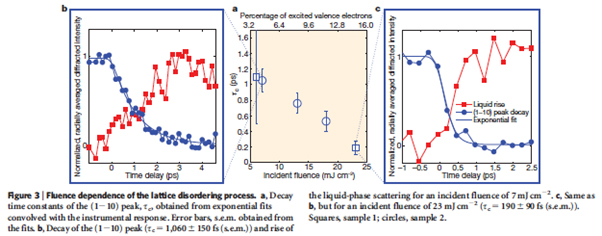Non-thermal melting
A laser with a femtosecond pulse width can create extremely strong electronic excitations, where more than a few percent of valence electrons are excited. Under such conditions, melting can occur on a time scale faster than thermal processes (e.g. phonon) which take a few picosecond.
This melting can be an irreversible process so that single shot capability is required in order to capture the transient dynamics. This is challenging with low electron energy instruments, where the number of electrons per pulse is kept low in order to minimise the space-charge effects.
The high energy electrons using a RF photocathode of RUEDI, on the other hand, allow single shot recording since a number of electrons per pulse is large i.g. 10^6 or more, without degradation of the pulse width. By recording single-shot diffraction patterns from many fresh areas, it is possible to capture non-thermal melting dynamics on an ultrafast timescale.
The pulse width of RUEDI goes down as low as 10fs that covers almost all frequencies in any materials where phonon frequencies are distributed up to 20 THz.
Reference: G. Sciaini, M. Harb, S. G. Kruglik, T. Payer, C. T. Hebeisen, F. -J. M. zu Heringdorf, M. Yamaguchi, M. H. Hoegen, R. Ernstorfer and R. J. D. Miller: Nature, 458 (2009) 56.

Image: Fluence dependence of the lattice disordering process. a, Decay time constants of the (1-10) peak, 1, obtained from exponential fits convolved with the instrument al response. Error bars, s.e.m. obtained from the fits. b, Decay of the (1-10) peak (t.-1,060 150 fs (se.m.)) and rise of the liquid-phase scattering for an incident fluence of 7 mJ cm. c, Same as b, but for an incident fluence of 23 mJ cm (t,-190190 fs (s.e.m.)). Squares, sample 1; circles, sample 2.